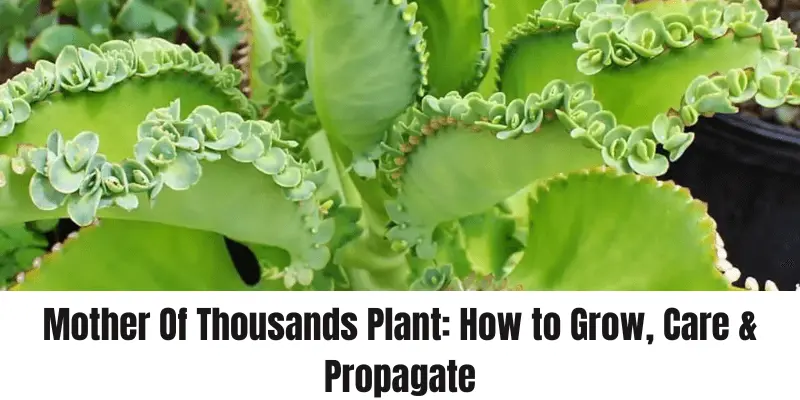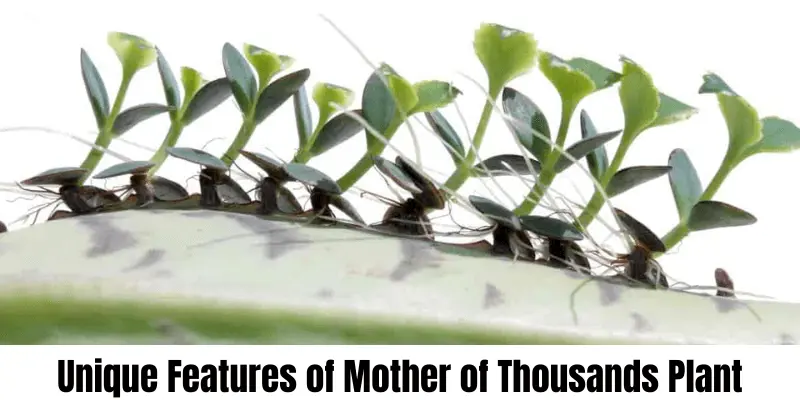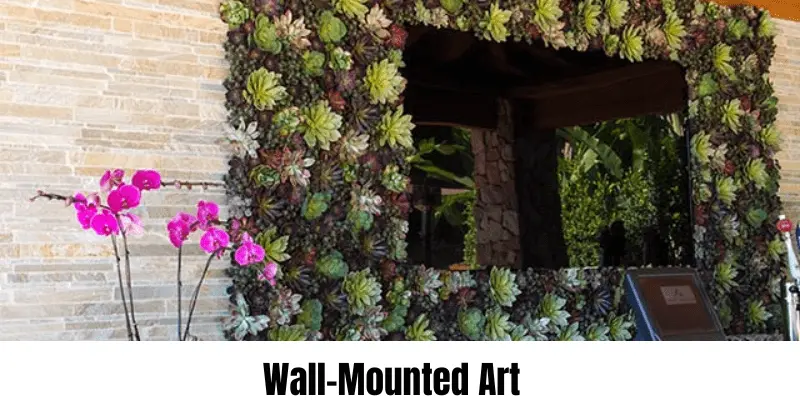Mother Of Thousands Plant: How to Grow, Care & Propagate

In the world of succulents, the Mother of Thousands plant stands out for its unique appearance and ease of care. Whether you’re a seasoned succulent enthusiast or a beginner looking to add some greenery to your space, this guide will walk you through everything you need to know about the Mother of Thousands plant, from growth and care to propagation.
1. Unique Features of Mother of Thousands Plant
The Mother of Thousands, scientifically known as Kalanchoe daigremontiana, is a captivating succulent native to Madagascar. Its striking appearance and ease of care have made it a popular choice among plant enthusiasts. This succulent is known for its unique propagation method, where it produces tiny plantlets along the edges of its leaves, resembling small “babies.”
The plant is recognized by its long, tubular leaves that are spotted with brownish-purple markings. Each leaf is lined with miniature plantlets, giving it an otherworldly appearance. These plantlets, once they fall to the soil, can take root and grow into new plants, hence the name “Mother of Thousands.”

2. Growing Your Plant:
When it comes to nurturing your beloved Mother of Thousands plant, understanding its unique needs is essential for its growth and prosperity. Following steps must be applied for proper growth.
Selecting the Right Pot
The choice of pot for your Plant is crucial to its well-being. Opt for a container with proper drainage to prevent overwatering, which can be detrimental to these succulents. When selecting the pot size, it’s advisable to start with a smaller one, allowing room for growth before considering repotting.
Soil Requirements
To ensure yourPlant thrives, it’s imperative to provide the right soil conditions. A well-draining soil mixture is ideal. Consider using a blend of cactus or succulent potting soil combined with perlite or sand to strike the perfect balance between moisture retention and drainage.
Light and Temperature Needs
Proper lighting and temperature conditions are paramount for your Plant’s growth. Place it in a location with bright, indirect sunlight. While it can tolerate some direct sunlight, be cautious about exposing it to intense, scorching rays. Maintaining temperatures between 60°F to 80°F (15°C to 27°C) is optimal for these succulents.

Watering and Feeding Your Plant
Watering your Plant requires a delicate touch. Allow the soil to dry out between watering sessions, typically every 2 to 4 weeks. Overwatering can lead to root rot, which can be detrimental to your plant’s health. During the growing season (spring and summer), consider fertilizing your succulent with a diluted succulent fertilizer every 4 to 6 weeks to promote healthy growth.
Pruning and Maintenance Tips
Regular pruning is essential for maintaining the shape and size of your Plant. Remove any dead or damaged leaves and plantlets to encourage healthy growth. Remember to wear gloves when handling these succulents, as their sap can be mildly toxic.
Dealing with Common Issues
While Mother Of Thousands Plants are relatively low-maintenance, they may encounter common issues like pest infestations or diseases. Keep a vigilant eye for mealybugs or aphids and address them promptly using neem oil or insecticidal soap to safeguard your plant’s well-being.
Caring for your Plant is a rewarding experience, but like any living thing, it can encounter common issues.
Identifying Pests
Keep an eye out for common pests that can affect your Mother Of Thousands Plant. These may include mealybugs, aphids, and spider mites. Watch for telltale signs such as discolored or distorted leaves.
If you spot pests, it’s crucial to act promptly. Use neem oil or insecticidal soap to gently treat the affected areas. Isolate the plant if necessary to prevent the pests from spreading.

Overwatering and Root Rot
Overwatering can lead to root rot in yourPlant. Signs of overwatering include mushy, discolored leaves and a foul odor emanating from the soil.
If you suspect overwatering, allow the soil to dry out completely before the next watering. Remove any damaged roots and repot the plant if the rot has advanced significantly.
Improper Drainage
These Plants require well-draining soil and pots with proper drainage holes. Without adequate drainage, the roots can become waterlogged, leading to various issues.
Ensure your pot has drainage holes and use a well-draining succulent soil mix. Elevate the pot slightly on pot feet or use a saucer to allow excess water to escape.
Inadequate Sunlight
Insufficient sunlight can cause your Plant to become leggy and pale. On the other hand, too much direct sunlight can scorch the leaves.
Place your plant in a location with bright, indirect sunlight. Rotate it periodically to ensure even growth and prevent leaning toward the light source.
Disease Concerns
While These Plants are generally hardy, they can still fall victim to diseases like fungal infections. Avoid overhead watering and maintain good air circulation to reduce the risk of disease.
If you suspect a disease, remove affected leaves and ensure the plant stays dry. Fungicides may be necessary in severe cases, but consult a plant expert for guidance.

Leaf Drop and Propagation
Don’t be alarmed if your Plant drops leaves occasionally. It’s a natural part of the plant’s growth cycle.
Take advantage of the dropped leaves by propagating new plants from them. Place the fallen leaves on well-draining soil, and new plantlets will emerge in due time.
3. Propagating Mother Of Thousands Plant
Propagation of the Mother Of Thousands Plant is a rewarding experience. Here are three methods to propagate your succulent:
Leaf Propagation
- Gently remove a healthy leaf from your Mother Of Thousands Plant.
- Allow the leaf to dry for a day or two.
- Plant the leaf, cut side down, in a pot with well-draining soil.
- Water sparingly until new growth emerges.
Offsets Propagation
- Carefully detach baby plantlets that grow along the edges of the leaves.
- Plant them in their own pots, providing well-draining soil.
Seeds Propagation
- Collect mother of thousands seeds from mature flowers.
- Sow the seeds in a well-prepared seed tray.
- Maintain soil moisture, and seedlings will typically emerge within a few weeks.
4. Mother Of Thousands Plant: A Unique Decor Element
Decorating your living space with the captivating beauty of Mother of Thousands plants can breathe life and charm into any room. Followings are creative ways to incorporate these plants into your interior décor.

Suspended Splendor: Hang your plant in stylish macramé hangers near windows or in well-lit corners. The cascading leaves create an enchanting visual effect, transforming your room into a green oasis.
Terrarium Elegance: Craft a captivating terrarium with a glass container. Fill it with layers of small stones, activated charcoal, and succulent soil. Add plants as the centerpiece for a mesmerizing, miniature garden.
Tabletop Centerpieces: Place small potted plants as delightful centerpieces on dining tables or coffee tables. Their unique appearance adds an intriguing focal point to your gatherings.
Floating Shelves: Arrange a collection of plants on floating shelves. Combine them with books, decorative items, or other succulents for an eye-catching display.
Windowsill Wonderland: Adorn your windowsills with a row of Mother of Thousands plants. Their ability to thrive in bright, indirect sunlight makes them perfect for this location.
Wall-Mounted Art: Transform your walls into living art by mounting a variety of small potted plants in decorative wall planters. Create your own masterpiece by arranging them in captivating patterns.

Mason Jar Magic: Repurpose mason jars or glass containers into charming plant pots for your Mother of Thousands. Place them on shelves or as part of a rustic-themed decor.
Hanging Gardens: Install floating wall shelves and position your plants on them. Let the plants cascade down naturally, creating an indoor hanging garden.
Desk Buddies: Liven up your workspace with a small potted plant on your desk. The touch of greenery can enhance your productivity and create a soothing atmosphere.
Bathroom Serenity: Add a touch of spa-like tranquility to your bathroom by placing a potted plant on a shelf or countertop. They thrive in the humidity of bathrooms and can elevate the overall ambiance.
5. Conclusion
In conclusion, the Mother of Thousands plant is a fascinating succulent that can be a delightful addition to your indoor garden. With its unique propagation method and relatively low maintenance requirements, it’s a perfect choice for both novice and experienced plant enthusiasts.


